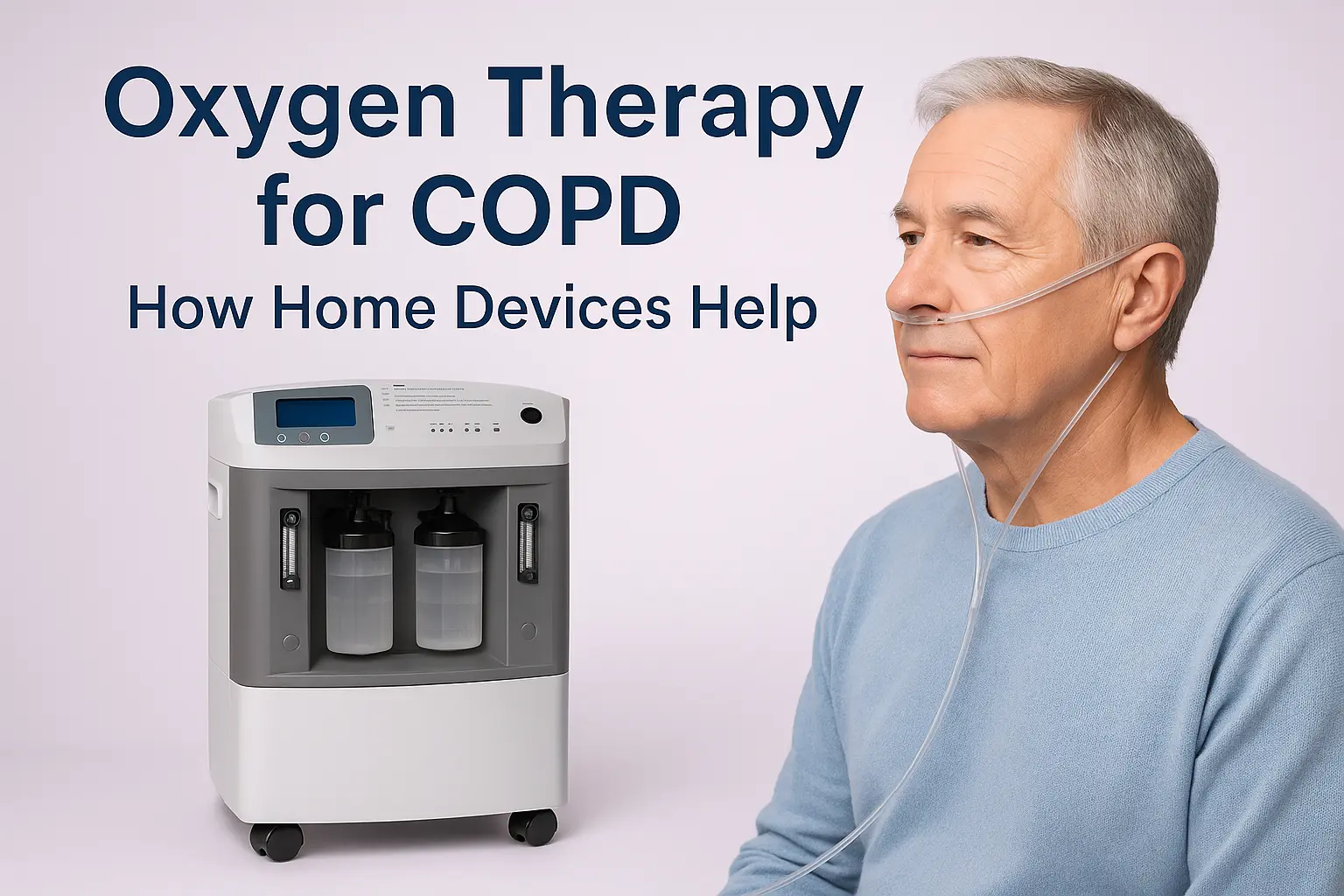

For people living with Chronic Obstructive Pulmonary Disease (COPD), even the simplest daily activities—like walking, eating, or climbing stairs—can feel exhausting. As lung function declines, oxygen levels in the blood drop, leading to shortness of breath, fatigue, confusion, and poor sleep.
That’s where oxygen therapy for COPD comes in. It’s more than just a medical treatment—it’s a lifeline that helps patients reclaim their comfort, mobility, and peace of mind. With modern home oxygen devices, families can now provide effective respiratory care right from the comfort of home.
This guide dives deep into how oxygen therapy works, the types of devices available, safe usage practices, and how trusted providers like Healthy Jeena Sikho are making oxygen support more affordable and accessible than ever before.
Oxygen therapy provides supplemental oxygen to patients who can’t get enough through natural breathing. For COPD patients, damaged lungs can’t efficiently transfer oxygen from the air into the bloodstream. Oxygen therapy compensates for this limitation, ensuring that vital organs—like the heart and brain—receive the oxygen they need to function properly.
Over time, consistent oxygen therapy:
When prescribed and managed correctly, oxygen therapy allows COPD patients to live longer, healthier, and more independent lives.
Benefits of Oxygen Therapy for COPD Patients
The advantages of oxygen therapy go beyond easier breathing—it supports the entire body.
When blood oxygen levels improve, patients experience less fatigue. Activities like cooking, walking, or socializing become more manageable.
Low oxygen levels during sleep can lead to restlessness and morning headaches. Oxygen therapy stabilizes oxygen saturation throughout the night, promoting restorative rest.
The brain depends on oxygen for concentration and mood regulation. Continuous oxygen supply helps reduce confusion, irritability, and anxiety.
By reducing the heart’s workload, oxygen therapy helps prevent strain and complications such as heart failure or pulmonary hypertension.
With improved stamina, sleep, and emotional stability, patients often regain confidence and independence, leading to a more fulfilling daily life.
Modern oxygen therapy is designed with flexibility and comfort in mind. There are two main types of home oxygen devices that cater to different patient needs.
These are durable, high-capacity machines ideal for home-based, long-duration oxygen use.
Key features:
They’re perfect for patients who spend most of their time indoors or require higher oxygen flow rates.
For active COPD patients who love staying mobile, portable oxygen concentrators are a game-changer. Compact, battery-powered, and lightweight, they allow patients to travel, go outdoors, or attend social events freely.
Advantages include:
Both options are available for rent or purchase through Healthy Jeena Sikho, allowing families to choose what best suits their lifestyle and medical needs.
While oxygen therapy is safe, it’s important to follow safety precautions to avoid fire hazards and ensure consistent therapy.
Following these simple steps ensures that oxygen therapy remains safe, effective, and stress-free at home.
When deciding between renting and buying an oxygen concentrator, consider the duration of therapy, cost efficiency, and maintenance convenience.
If oxygen therapy is needed temporarily (such as after hospitalization or during recovery from infection), renting is the most economical option.
Benefits:
For example, patients can rent oxygen concentrators in Delhi through Healthy Jeena Sikho, which provides free delivery, installation, and 24x7 technical support.
For long-term or chronic COPD management, owning a concentrator is more cost-effective.
Healthy Jeena Sikho offers:
Whether renting or buying, professional setup and regular servicing are essential for safe, continuous therapy.
Oxygen therapy works best when combined with healthy habits and mindful living. Small lifestyle changes can multiply its benefits.
Smoking accelerates COPD progression and counteracts the benefits of oxygen therapy. Both patients and caregivers should maintain a smoke-free environment.
Eat small, balanced meals rich in fruits, vegetables, and lean proteins. Avoid processed foods that can cause bloating or water retention.
Regular physical activity—like walking, breathing exercises, or pulmonary rehab—helps strengthen respiratory muscles.
Breathing exercises, meditation, and counseling can help patients manage anxiety, which often worsens breathlessness.
Frequent consultations help doctors adjust oxygen flow, medications, and monitor lung function for ongoing progress.
Together, these habits ensure that oxygen therapy is not just a treatment, but a pathway to improved well-being.
Oxygen therapy for COPD is more than a medical recommendation—it’s a promise of comfort, stability, and hope. With the right equipment, guidance, and care, patients can rediscover the joy of everyday life without constant struggle for breath.
At Healthy Jeena Sikho, we provide reliable home healthcare solutions, including oxygen concentrators, BiPAP, and CPAP machines for rent and sale in Delhi NCR. Our goal is to make advanced respiratory support accessible, affordable, and stress-free for every family.
💙 Check oxygen concentrator rental options in Delhi today and take the first step toward breathing easier with Healthy Jeena Sikho.
Oxygen therapy delivers purified oxygen to patients whose lungs cannot absorb enough from the air. It helps maintain healthy blood oxygen levels, reduces fatigue, and improves overall comfort and activity.
A doctor may recommend oxygen therapy if your blood oxygen level (SpO₂) consistently falls below 88%. Tests like pulse oximetry or arterial blood gas analysis confirm this need.
Yes, depending on your doctor’s advice. Some patients need oxygen continuously, while others only during sleep or activity. It’s important to follow prescribed usage exactly.
Yes—when used responsibly. Avoid open flames, oil-based products, and smoking near the device. Always store equipment in a ventilated, dry place.
Stationary concentrators are powerful machines designed for continuous home use, while portable concentrators are battery-operated units suitable for mobility and travel.
You can rent oxygen concentrators in Delhi easily from Healthy Jeena Sikho, which offers flexible rental plans, home delivery, installation, and full technical support.
If you need oxygen for a short time, renting is more affordable. For chronic or long-term conditions, purchasing a concentrator can save money in the long run.
Wipe the exterior regularly, clean air filters weekly, and replace nasal cannulas as recommended. Always unplug the device before cleaning.
Yes, for patients who also have sleep apnea or advanced COPD, oxygen therapy can be safely combined with BiPAP or CPAP under medical supervision.
Healthy Jeena Sikho offers top-quality oxygen concentrators for rent or sale in Delhi NCR, with professional installation, maintenance, and round-the-clock support—ensuring safe, worry-free care for COPD patients.